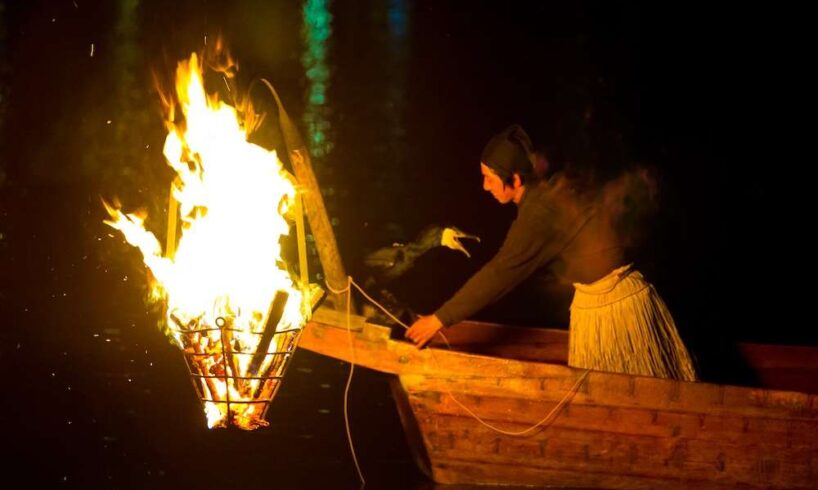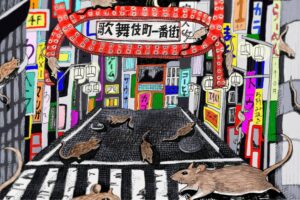
Anyone who has ever cast a dry fly into a lake or stream knows that feeling. All is quiet, all is peaceful—then bam! A hungry mouth breaks the surface, the fly disappears into the depths, and the world becomes a thrashing primordial tug-of-war between worlds—man versus scaly beast.
For hundreds of years, the Coast Salish people of British Columbia constructed massive weirs from willow trees to corral salmon as they migrated upstream to spawn. Hawaiian slings are designed to shoot their prey like an underwater bow and arrow. In the American South, brave noodlers stick their hands into catfish holes with their own fingers as bait. And in one small village in Scotland, flounder trampers walk into the shallows and simply step on their fish.
Tickling, gigging, binning, gaffing, gillnetting, harpooning, handlining, seining, trawling, jigging—there might be even more ways to catch a fish than to cook one.
Japan’s Deep Connection to Fishing
Bound by the sea and blessed with numerous rivers and streams, Japan has long been known as a nation of fish lovers, with different regions developing particular local cuisines along with unique methods for procuring a tasty catch. Ukai, the ancient Japanese tradition of fishing with tame cormorants, is surely one of the most unusual.
Credit: Kuochuan Cheng
Practiced in Japan for at least 1,400 years, ukai claims its origins from the Nagaragawa River in Gifu, where it endures to this day. The basic process involves tying loose wire rings around the long necks of the cormorants, enabling the birds to swallow small prey but causing larger fish to become stuck in the gullet. The fisherman, known as an usho, then pulls the cormorant back to the boat where he extracts the fish. The most sought-after catch is the ayu, a freshwater sweetfish prized for its delicate texture and flavor.
While ukai in Gifu was once a practical form of obtaining fish to be consumed and sold, these days it survives for its cultural value. The traditions and skills handed down from parent to child through countless generations have led to ukai being designated as an Intangible Cultural Property of Japan and formally recognized as Goryo Ukai (Imperial Cormorant Fishing) by the Japanese Imperial Family.
A Spectacle for Lords, Warlords and Travelers
The entertainment value of ukai fishing was also recognized hundreds of years ago by the Japanese elite. As far back as the Heian period (794-1185), lords and ladies from the Imperial Court in Kyoto gathered on a pleasure craft to watch the usho and their birds in action.
The warlord Oda Nobunaga was also charmed by ukai. After seizing Inabayama Castle by the Nagaragawa in 1567 and renaming it Gifu Castle, he began to invite friends and loyalists such as Takeda Shingen and future shogun Tokugawa Ieyasu to observe the cormorants and their masters at work, followed by banquets featuring their fresh sweetfish catch.
Visiting Gifu Today: Modern Ukai Performances
These days, a modern reconstruction of Gifu Castle perches beautifully, if ahistorically, atop Mount Kinka at a bend in the Nagarawa River, a picture-perfect backdrop to modern demonstrations of ukai. These ukai performances are held from May to October each year, drawing in curious onlookers from all over the world. Guests are taken out onto the river at dusk in long wooden boats, each tipped with a basket containing a blazing fire that attracts fish and provides the boatman and his cormorants with a light by which to see.
If you are picturing a man and a bird linked by a single rope, think again. Each usho—clad in traditional blue shirt and hat to fend off sparks and ashes from the flames—controls his own personal fotilla of 10-12 cormorants like a master puppeteer, keeping a careful eye on the birds as they plunge underwater to catch fish. When I first witnessed it in person, the comparison that came to mind was not fishing-related at all, but of my father’s hunting dogs in Canada, ranging out in front of him, searching for birds to flush out of their hiding spots.
With flaming lanterns, dramatic scenery and trained diving birds, it is a wonderful spectacle unlike anything you will see elsewhere in the world. But at the end of the evening, as you sit down to your lavish post-ukai meal, it ultimately comes down to the simple pleasure of catching—and eating—fish.
This article was originally published in the Summer 2025 Issue of Metropolis Magazine, “Water.” Read the full issue here.
Read on:
Exploring Mitsuiboshi Kaido: Japan’s Artisanal Heartlands
Ama: Women of the Sea





